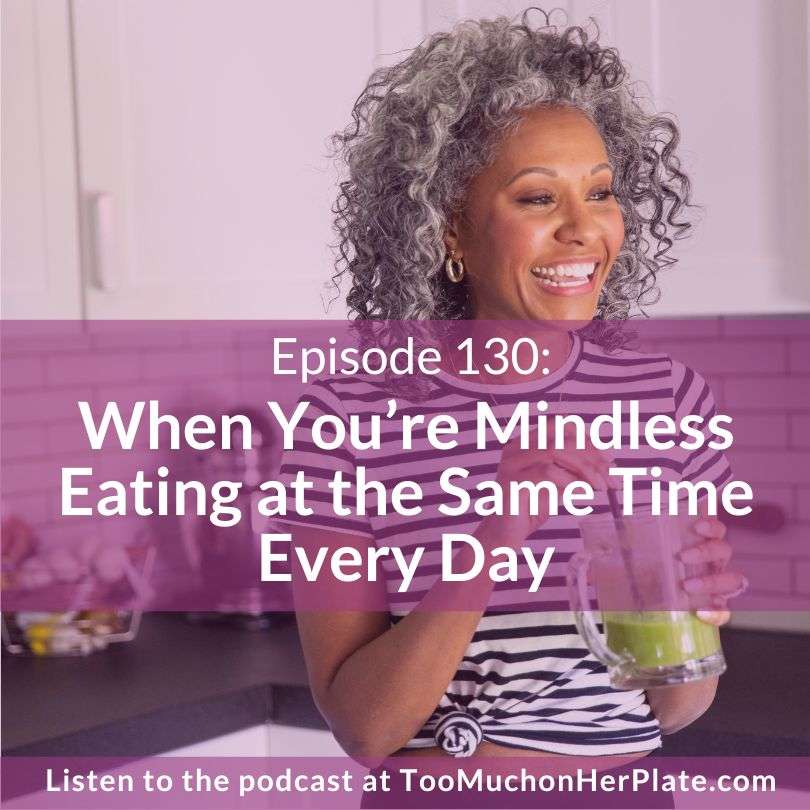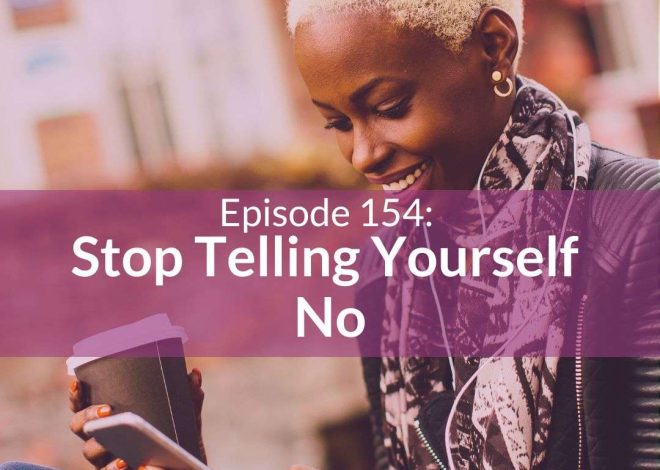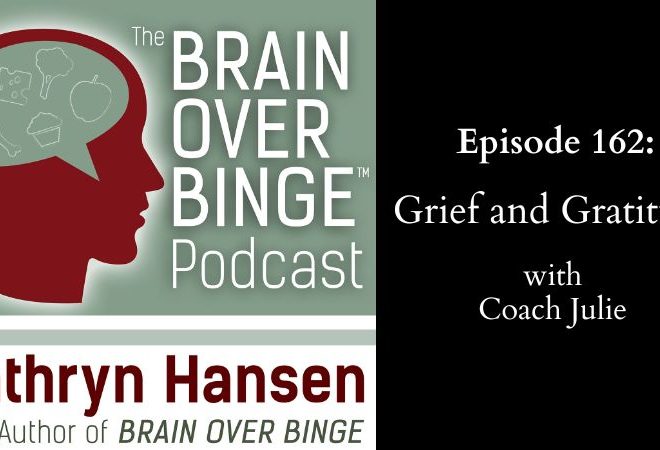
When You’re Mindless Eating at the Same Time Every Day
Hey everybody. So the other day, it was actually yesterday, I went for a walk with a friend of mine after work. I got done with work. I finished up what I was doing. I changed my clothes really fast. I grabbed my coat. I headed out the door.
And it was really nice. It was a great way to end the day. We had some good conversation. It was a lovely sunny evening. I got to be outside. I got back at just about dinnertime, came into the house, took off my shoes, hung up my coat, walked into the kitchen. The plan in my head was, okay, I’m home for my walk now. Now I need to get dinner started.
But first I opened the pantry and there I stood looking for a little snack. Not because I was hungry, not because there was something there that I really wanted to eat, but just because sometimes that feels like the routine. And I’m wondering if you can relate to this or if you have been there.
So you walk in the door and you just head to the kitchen. That’s kind of like the trail. Right? Or you hit end meeting on a work call and you go for a snack. Or you finish up dinner and all that you want to do in the kitchen is all done. And then you circle back for one more little thing before you leave. And you don’t understand why you always do that. Or maybe it happens before you head to bed at night.
I want to share with you today, some very eye opening coaching that happened inside your missing piece recently. Your Missing Peace is my group program, where I help a small, amazing community of women break overeating and emotional eating habits. So as you might imagine, these mindless routines that I just described for you are a pretty important thing to look at. Right?
In fact, I think that the topic of mindless routines and looking at how they fit into your pattern of overeating is so important for changing your eating habits. And it is incredibly overlooked and ignored. And I also think this particular topic, this particular issue, these mindless habits and routines around food are becoming more and more of an issue and of an overeating trigger in our culture.
All of the examples that I shared a minute ago are examples of eating that happens in the midst of switching gears. In the space between two things or two activities or two different moods or two different sets of expectations. All of the examples are related to transitions.
I’ve talked about transitions before on the podcast. That space that we have, that’s what a transition is. It’s a space that we have or that we don’t have between things. The transition from one thing to another. So between work and after work. Between dinner and bedtime. Between the end of a meeting and the next thing that you have decided that you’re going to do or that you have to do that’s on your schedule.
A transition is that thing that happens between the end of lunch and moving into your afternoon. So it can be a switch between activities. And many times it’s also a switch between roles or a switch between kind of the energy or the emotion that that goes into those things. A key piece of understanding transitions is taking into account that this is a time when you are often switching gears.
Transitions are incredibly important times. They have the potential to be so powerful both for good and also in a negative way. And yet Transitions are virtually ignored. And I am pretty willing to bet that no one, unless you work with me, no one has ever asked you to consider how you want your transitions to feel. How you want your transitions to work for you. Right? How do you want your transitions to be? What do you want them to be like?
The things that I think and that I do in that space between things, again, like I said, it’s very powerful. The things that I think and do in that space can energize me. They have the potential to refresh me. To clear my mind so I can focus on the next task. To fuel me, to create clarity. The things I do in that space might provide a break, a resting spot, even if it’s just a brief little pause.
The things that I think and do in that space, or that I don’t think, or do in that space can also send me into a really negative thought spiral that leads to procrastination. Or that takes me down a path where the next thing takes way longer than it needed to. I can create overwhelm when I don’t allow myself a space between things.
Or very often when things actually overlap, we live in a world where not only. Are we cheated out of transitions and cheating ourselves out of transitions, but we also live in a world where literally things are overlapping. People are booked into two things at once. You are running from one thing, prepping for the next thing before you’ve ever finished up the thing that ended. Right? And when that happens, you never get to focus your mind on the present.
I have been doing this work for a very long time. And I have come to, I was going to say I’ve come to believe, but I have come to know that many humans, especially smart, busy women with a lot on their plates could absolutely upgrade their approach to the multiple transitions. Which can be big and small, by the way. There are all sorts of transitions, the multiple transitions that happen every single day.
Most of us could upgrade our approach to these things. And as I have said before, one of the ways you might be actually creating a transition or trying to hold room for a transition or trying to take care of yourself during a transition, trying to slow yourself down or switch gears is with an autopilot habit of eating or overeating. That habit of wandering into the kitchen. Or wandering to the vending machine. Or heading to the drive through or going back for a little bit more may very well be a way of you attempting to take care of yourself and to switch gears, or to slow yourself down so you don’t have to switch gears so quickly.
I want you to really think about this. Be curious about this. See if you recognize a pattern. You get done with the thing and you crave a snack. I walked in the door. I went to the kitchen. Dinner’s over. I’m not sure or I’m not happy about what the next thing is on my to do list, so I have a little more of the leftovers. Or I want something sweet, or I want a little snack that I know I don’t really even want. Does this sound familiar? Is there a part of you that resonates with this pattern or a pattern that feels similar?
I told you that there was some powerful coaching that happened inside Your Missing Peace about this topic. What happened was I asked the question, how do you switch gears? What does that look like in your life? How do you switch gears? What do you think? Or what do you do? Or how do you set up your environment to help you switch gears between things?
These are really big questions. And I want you to be curious, if these are new questions to you, if you haven’t thought about this before, I want you to be curious about that. Because there’s something very interesting about the fact that we don’t pay attention to this stuff. And I’m not saying that in a blaming way, I’m, I’m saying as a society and in specifically in the approach that is so often taken around changing eating habits, we don’t talk about these things.
I talk about these things. Work with me and you’re going to hear a lot about these things. But traditional approaches do not. So I want you to take a moment and really think about this. How do you switch gears? What does it actually look like when you are switching gears between one thing and another, one activity or another?
Consider this question, and you might think about it globally. What do I do in general when I’m switching gears? Or think about a specific transition in your life, a specific time of day. Maybe pick one where you’re not feeling absolutely thrilled about your eating or where it’s a really big problem.
What are, what are the things that you are transitioning between and what does it look like? How are you currently switching gears? What do you do to switch gears? What are your thoughts at that time? How are you feeling about switching gears? And how’s it working?
There is so much room for curiosity here. It, it can also be very valuable to take a look at whether or not you give yourself time and space to actually switch gears. Maybe you have thoughts that rush you on that, that kind of minimize the need to switch gears and just tell you, you need to keep going. You shouldn’t need to do whatever the thing is that you’re feeling. You shouldn’t need a break. You shouldn’t need to stop. You just need to get onto the next thing.
When you work with me, we exercise your curiosity muscle big time. And part of that process is often asking yourself questions that you might not like the answer to, or you might not actually know the answer to. This might be something you need to consider. How do I switch gears? I want to look at that. Right?
Or you might fall in the camp of, I do it in ways that are not helpful to me, or I deny my need to switch gears. I don’t do transitions. I ignore them. I power through them. You probably won’t be surprised that just about everyone in Your Missing Peace, when I asked that question, could pinpoint places where they were or where they used to be using food and eating as the way to switch gears. Or as a way to avoid moving on or to do whatever was next or as a way to slow things down or take a break.
Here’s what’s interesting. The next question that I asked inside the program was, okay, so this is how you switch gears now, this is what it looks like, or this is how you’re not switching gears, this is the situation. If you could wave a magic wand and you could just make it so by waving that wand, how would you like to switch gears in this situation?
So whatever the situation is where you’re not happy about the way that you’re doing it or where it isn’t giving you a good outcome. So maybe you’re ending up in the kitchen eating all the things.
How would you like it to go? What would you like to do? How would you like this gear switching to feel? How do you want the gear switching experience or the time that you have switching gears? That transition, how do you want that to prepare you for the next thing? What are you needing in that little interval?
And inside the program, there were a number of ah hahs, as just about everyone realized that they had never really thought about this in this particular way before. You all, we always eat for a reason. Every. Single. Time. You eat for a reason.
If you are feeling powerless before chocolate every day at 3 p. m., there’s a reason. Maybe it’s hunger. Maybe you need fuel. Maybe you’re tired. Maybe it’s boredom. Maybe, and quite possibly, it is an automatic habit that you have created as a way of coping in a transition. Maybe, and quite possibly, it is something you are doing in an attempt to help yourself with switching gears.
We live in a culture that glorifies and promotes and pushes us into constant activity. People even brag about how tired they are. That has become a badge of honor and multitasking is out of control.
You are human. I am human. When I walked in the house ready to throw off my coat and get dinner started, I was completely overriding my very human need to switch gears. I was completely overriding my need to move my mind from being out on a walk with my friend and move it into the space of being at home at the end of the day.
Even though these experiences that I was transitioning between were happy experiences, they were calm experiences, I still needed a little space. I needed space so I could be present in the space in between. And then I could be present in the space I was moving into. I didn’t need a snack, but I was reaching for that snack for a reason. Because I needed a transition.
In this situation, in my particular situation, I noticed it. I saw myself doing this, and I took just a few minutes to do some things that I have found help me switch gears. Very basic things. I changed my shirt. I washed my face. I took out my contact lenses. Those are just a few things that have, for me, come to signal the end of the day.
And then I went to think about dinner. Then when I gave myself just that little bit of space to switch gears, I could be present thinking about dinner. So often we focus on what we don’t want. The things we don’t want to do. I don’t want to come home and eat all the things I don’t want to eat before I go to bed.
I don’t want to dot, dot, dot, dot. Right? You know how it goes. I’m sure you have a list in your mind. We can craft those lists of what we don’t want to do in our sleep. However, the payoff, the real payoff comes when you craft a plan for what you do want. What do you want? What do you want it to look like?
You are going to need to switch gears multiple times today. No matter what time you’re listening to this, there’s probably going to be a transition ahead of you. So take the time to consider one of those gear switching times. One of those transitions.
How can you take care of yourself during this transition? What will help you switch gears? How do you want to feel going into the next thing? And what can you do in a little bit of space that would help you create just a little bit more of that?
When you create the change that you want to have, the eating that you don’t want to do is going to feel less compelling. That is absolutely the truth. So pay attention. Think about switching gears. Think about what it looks like, and think about what you want.
I’ll talk to you soon.


